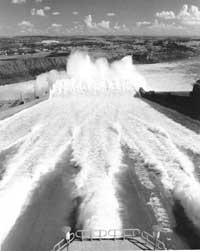Dams more harmful than expected

Between 1950 and 1982, about 30,000 dams were built, of which more than 18,000 were built in China. By the early 1990s, 13% of the flow of rivers that flow into the sea was collected at the dam or diverted the water stream. This percentage is expected to exceed 20% for the first years of the next century.
Unfortunately, most built dams can cause unexpected problems. A significant example is the Iron Gate Dam, which crosses the Danube River from about 1,000 kilometers from the mouth to the Black Sea. According to researchers, Danube has lowered its silicon level to the sea and is changing the production of raw materials in the Black Sea. This phenomenon is the first to be deducted; the decrease in silicon has also been detected in other studies. But what can become a top news item is a problem that can affect the environment. In addition, the risk of ecological damage is not only present in estuaries and coasts, but also in large areas such as the Black Sea.
The Nile River as a representative case
Well-known environmental studies highlight the harmful effects of the dam and the diversion of rivers. For example, Asua dam water softened the drought in Egypt in 1980, but the dam itself has already brought negative consequences for the river and the Mediterranean coast of Egypt. Erosion seriously cuts the river bank. Much of the sediments and water transported by the Lower Nile are trapped in dikes and drainage channels and irrigation without reaching the delta. Therefore, few waters and barely sediments reach the Mediterranean. Its effects are the exhaustion of fishing, the increase in coastal erosion, the increase in marine and land pollution and the eutrophication of coastal lakes and lagoons, among others. According to the researchers, the new irrigation plan of the Asuan River will mean a lower mouth of the Nile River in quantity and quality.
Another notable case is the Mississippi Delta. The construction of large dams and dams has reduced flooding and the amount of sediments in the areas near the mouth. The accumulation of sediments does not compensate for natural erosion, with the consequent loss of coastal lands and the proliferation of lakes and lagoons.
The 1988 agreement between India and Bangladesh on Ganges waters in Asia caused unexpected consequences. The works of the Farakka Dam in India reduced the waters leading to Bangladesh by 75%. The rich lands became deserts, appearing salt water in the territories of Sundarbans (extensive mangrove forest and natural habitat of the Bengal tiger). Bangladesh's annual losses reach four billion dollars. In the future, the lack of water from the river downstream of the Farakka dam will cause an increase in groundwater extraction. Consequently, erosion and descent of delta lands will intensify, increasing sea level.
Troubling impacts
Small rains on the Yellow River in the US and dams built on the upper part of the river have halved the mouth of water and sediments, which in 1995 completely dried up for four months. If the mouth of the sediments continues to descend, the river delta is in danger (and take into account the abundance of oil in the area).

Most of the documents on dams in rivers speak in the journal Nature of the aforementioned damages. On the other hand, Humborg and its co-workers have recently published an article stressing that in the long term the biological and chemical environment of the coasts will change drastically and other phenomena will occur. Increased soil conservation and diversion of river waters will, on the one hand, cause a decrease in sediment loads and, on the other, an increase in food transport due to agricultural fertilizers, which will increase eutrophication and decrease oxygen levels on the coasts of Europe and North America.
According to the Humborg group, the decrease in the amount of silicon and water in the Danube River has led to a decrease in the concentration of silicon on the total surface of the Black Sea. It should be noted that 70% of the freshwater that reaches the Black Sea comes from the Danube. According to scientists, a consequence of the decrease in silicon level has been the change suffered by phytoplankton species, which have gone from being siliceous to non-siliceous. The decrease in the mouth of the river waters would in turn have a notable influence on the traffic of the Black Sea. In the rivers Dnieper, Don, Rioni and Sakarya, in other great rivers that flow into the Black Sea, if they do dams, the fresh water would arrive very little. All this would have serious consequences. In addition, decreased water flow from the Black Sea and the Nile Dam can significantly affect the amount of fresh water in the eastern Mediterranean.
As scientists investigate to better understand the interactions between land and sea, we will be on the best occasion to see how to minimize the harmful effects of new work on rivers. Therefore, in some cases of dams the most important thing to decide is not whether to make the dam, but how to do it.





